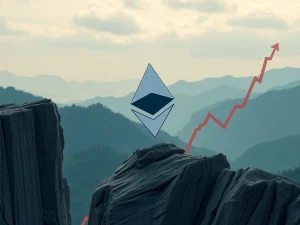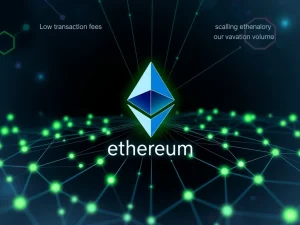Ether ETF Inflows: Unlocking Crucial Opportunities for Crypto Traders in 2025

The cryptocurrency market often surprises investors. Specifically, a significant shift occurred in August 2025. **Ether ETF inflows** dramatically outpaced Bitcoin ETF performance. This divergence has ignited fresh discussions among **crypto traders** about Ether’s growing influence. Ether (ETH) continues its evolution beyond a mere digital asset. It serves as the fundamental layer for decentralized finance (DeFi), non-fungible tokens (NFTs), and smart contracts. These applications provide tangible utility, often surpassing Bitcoin’s primary function as a store of value. Consequently, 2025 marks a pivotal year for Ether’s integration into mainstream finance. The emergence of spot **ETH ETFs** offers institutional investors a regulated and accessible gateway to gain exposure to ETH. This year, the narrative extends far beyond just Bitcoin ETFs. According to SoSoValue data, Ether ETFs attracted a remarkable $3.87 billion in net inflows during August 2025. Conversely, Bitcoin ETFs experienced $751 million in outflows over the same period. This striking difference fuels speculation about the “flippening.” This term refers to the potential scenario where Ether might one day challenge Bitcoin’s market dominance. For discerning **crypto traders**, this momentum provides a critical **market signal**. ETF inflows frequently precede substantial price movements, making them essential to monitor.
Understanding Ether ETF Inflows and Their Market Impact
Before analyzing the deeper implications, it is crucial to clarify what **ETH ETFs** are and why their inflows matter. Currently, Ether ETFs hold approximately $28 billion in assets. This represents about 5% of ETH’s total market capitalization. These funds are gaining considerable momentum as inflows accelerate. Yet, Bitcoin ETFs still maintain a larger overall asset base. An Ether ETF is a fund traded on traditional stock exchanges. It allows investors to gain exposure to ETH without the complexities of direct purchase or storage. There are key distinctions to understand. A **spot ETF** holds actual Ether directly. Meanwhile, a **futures ETF** tracks ETH futures contracts. Inflows represent the net amount of money entering these ETFs. Positive inflows suggest strong demand and investor confidence. Conversely, outflows indicate selling pressure. Recent data from late August/early September 2025 highlights the market’s growing significance. BlackRock’s ETHA ETF, for instance, holds around $16 billion in net assets. Grayscale’s ETHE manages roughly $4.6 billion. Fidelity’s FETH boasts about $3.5 billion. Combined, Ether ETFs account for approximately $28.8 billion. This figure signifies about 5.3% of Ether’s total market capitalization. Bitcoin ETFs remain larger, with BlackRock’s IBIT leading at roughly $82 billion. However, the consistent **Ether ETF inflows** demonstrate a clear shift in momentum towards Ether. Did you know that on August 29, 2025, both spot Bitcoin ETFs and Ether ETFs saw simultaneous pullbacks? Bitcoin ETFs recorded $126.6 million in outflows, and Ether ETFs lost $164.6 million after hotter US inflation data. This marked the first such joint decline in weeks, illustrating market sensitivity.
Why Institutional Demand for ETH ETFs Matters for Crypto Traders
ETF inflows are more than just mere statistics. They function as potent **market signals**, revealing how institutional investors position themselves. Therefore, **crypto traders** should closely watch these figures. These numbers often align with shifts in price trends and overall liquidity. Rising inflows indicate that hedge funds, pension funds, and asset managers are increasingly betting on ETH’s future. This signals growing confidence in its long-term viability. Furthermore, increased ETF demand effectively pulls ETH off exchanges. This action reduces the available supply and can consequently push prices upward. Historical parallels underscore this importance. In 2021, crypto ETFs amassed around $7.6 billion in net inflows. This influx significantly helped fuel Bitcoin’s rally to fresh all-time highs. A recent example vividly illustrates this impact. On July 16, 2025, Ether ETFs recorded an unprecedented $726.6 million in single-day inflows. This record-breaking amount coincided with ETH testing the $5,000 level before a slight pullback. Additionally, in late August 2025, US spot **ETH ETFs** logged their second-largest daily inflows ever at $729 million. Just days prior, they set another record of $1.02 billion. Over a three-day span, inflows reached $2.3 billion. The cumulative totals surged to a new peak of $12.1 billion as ETH approached its all-time high. For **crypto traders**, monitoring platforms like SoSoValue, CoinShares, and Farside Investors provides early insight. These tools help determine whether institutional flows are accelerating or slowing down, offering valuable predictive power.
Navigating Short-Term Price Action Driven by Ether ETF Inflows
Significant **Ether ETF inflows** can dramatically affect short-term price action. As billions of dollars move into these ETFs, the available ETH supply on exchanges naturally decreases. This reduction creates upward price pressure. However, it also fuels volatility when markets tend to overreact. Short-term impacts for **crypto traders** include: Price Momentum: Inflows frequently generate price surges as demand spikes. ETH rising more than 40% in July 2025 serves as a clear example. Volatility: Despite strong inflows, ETH dropped 4% in 24 hours after failing to sustain the $5,000 level. Traders must prepare for such rapid pullbacks. Options Market Impact: Rising inflows often increase implied volatility. This creates opportunities for options sellers to capture premium. Arbitrage Potential: Price gaps sometimes emerge between ETF shares and ETH spot markets. Sophisticated traders can exploit these discrepancies. Traders should also monitor specific strategies. These include momentum trading during inflow surges. Hedging exposure using futures or options when inflows peak is another crucial tactic. Watching ETH reserves on exchanges also acts as an early warning system for potential price squeezes. Short-term **crypto traders** can certainly profit from this volatility. However, they must maintain strict discipline with risk management. Sudden reversals remain common in dynamic crypto markets. Did you know that Ether hit a new all-time high of $4,945 in August 2025? This achievement broke its November 2021 record of $4,878, as these institutional inflows fueled fresh momentum.
The Path to Long-Term Institutional Adoption for Ethereum
Beyond short-term volatility, the consistent rise of **ETH ETFs** signals deeper **institutional adoption**. This trend holds significant implications for long-term stability, liquidity, and ETH’s role as a global financial asset. Corporate treasury adoption is visibly growing. SharpLink Gaming, for example, added over 800,000 ETH to its balance sheet this year. ETHZilla increased its reserves to more than 102,000 ETH. BitMine Immersion Tech now holds over 1.8 million ETH, making it the largest publicly traded ETH holder. Furthermore, institutional sentiment continues to shift. VanEck CEO Jan van Eck has famously called ETH “the Wall Street token.” He emphasized its crucial role in stablecoin transfers and broader financial infrastructure. Currently, **ETH ETFs** represent more than 5% of the total ETH market capitalization. This marks a significant milestone for mainstream adoption. Potential long-term benefits are substantial. They include greater liquidity and reduced volatility as ETF participation deepens. New demand from pension funds, family offices, and insurance companies will also emerge. Increased integration of ETH into traditional financial systems is expected. This integration will become even more pronounced if staking is approved for ETFs by the end of 2025. Ether’s inherent utility extends beyond being a mere store of value. Its vital role in DeFi and enterprise applications makes it exceptionally attractive as a long-term institutional asset. Therefore, its financial products are gaining traction.
Key Risks and Challenges for Crypto Traders in the ETF Era
Despite the impressive growth of **Ether ETF inflows**, **crypto traders** should remain vigilant. Several risks could impact the market in the near term. These challenges affect both retail and institutional participants. First, regulatory uncertainty persists. US lawmakers have introduced measures like the GENIUS Act and CLARITY Act. These represent steps toward clearer rules for crypto. However, regulation remains unpredictable. The US Securities and Exchange Commission could alter its stance quickly. New restrictions on ETF approvals, staking features, or compliance requirements could reduce institutional demand. Second, competition with Bitcoin ETFs is fierce. Bitcoin ETFs still dominate the market with over $100 billion in assets. BlackRock’s IBIT alone leads with around $82 billion. While **ETH ETFs** are gaining traction, Ether must sustain inflows. This is essential to prove long-term staying power. Traders should remember that Bitcoin continues to be the benchmark institutional asset. This might limit ETH’s momentum in certain periods. Third, over-reliance on ETFs can be risky. Strong inflows often create bullish narratives. However, heavy outflows can just as easily spark sharp declines. Traders should avoid basing decisions solely on ETF data. Instead, consider other signals such as exchange reserves, technical analysis, and macroeconomic conditions. A diversified approach reduces the risk of being caught off guard by sudden market reversals. Fourth, volatility remains high in early phases. Like Bitcoin ETFs in their initial years, Ether ETFs are still new. They may bring heightened volatility. Price swings of 10% or more are possible, even in response to modest news events. **Crypto traders** must use robust stop-loss strategies, appropriate position sizing, and proper hedging. These tactics help overcome this early-phase turbulence. Ultimately, understanding these risks is crucial for navigating the evolving crypto landscape.









